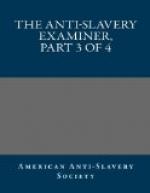Why, we ask, was this surgery established ’for the treatment of negroes’ alone? Why were these ‘interesting cases’ selected from that class exclusively? No man who knows the feeling of slave holders towards slaves will be at a loss for the reason. ‘Public opinion’ would tolerate surgical experiments, operations, processes, performed upon them, which it would execrate if performed upon their master or other whites. As the great object in collecting the disabled negroes is to have ‘interesting cases’ for the students, the professors who perform the operations will of course endeavor to make them as ‘interesting’ as possible. The instruction of the student is the immediate object, and if the professors can accomplish it best by protracting the operation, pausing to explain the different processes, &c. the subject is only a negro, and what is his protracted agony, that it should restrain the professor from making the case as ‘interesting’ as possible to the students by so using his knife as will give them the best knowledge of the parts, and the process, however it may protract or augment the pain of the subject. The end to be accomplished is the instruction of the student, operations upon the negroes are the means to the end; that tells the whole story—and he who knows the hearts of slaveholders and has common sense, however short the allowance, can find the way to his conclusions without a lantern.
By an advertisement of the same Medical Institution, dated November 12, 1838, and published in the Charleston papers, it appears that an ‘infirmary has been opened in connection with the college.’ The professors manifest a great desire that the masters of servants should send in their disabled slaves, and as an inducement to the furnishing of such interesting cases say, all medical and surgical aid will be offered without making them liable to any professional charges. Disinterested bounty, pity, sympathy, philanthropy. However difficult or numerous the surgical cases of slaves thus put into their hands by the masters, they charge not a cent for their professional services. Their yearnings over human distress are so intense, that they beg the privilege of performing all operations, and furnishing all the medical attention needed, gratis, feeling that the relief of misery is its own reward!!! But we have put down our exclamation points too soon—upon reading the whole of the advertisement we find the professors conclude it with the following paragraph:—




